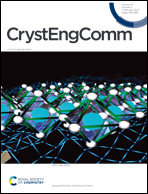Revealing the supramolecular features of two Zn(ii) complexes derived from a new hydrazone ligand: a combined crystallographic, theoretical and antibacterial study†
Abstract
A new hydrazone ligand, HL [(1-methylimidazol-2-yl)methylene]isonicotinohydrazide, has been synthesized and characterized by several spectroscopic methods. The ligand (HL) was then utilized for the preparation of two new complexes, namely, [Zn(L)2]·2H2O (complex 1) and [Zn(H2L)Cl3]·H2O (complex 2). The crystal structures of these complexes have been established by single-crystal X-ray analysis. The non-covalent interactions and supramolecular assemblies observed in the crystal packing of both complexes have been described focusing on π⋯π (for 1) and O⋯π–hole (for 2) interactions along with various hydrogen bonding interactions. A DFT study has been carried out to analyse their non-covalent interactions with rationalization using molecular electrostatic potential (MEP) surfaces and the combined QTAIM/NCI plot computational tools. In addition, the in vitro biological activities of the synthesized ligand (HL) and the water-soluble complex 2 were evaluated against Escherichia coli and Staphylococcus aureus.



 Please wait while we load your content...
Please wait while we load your content...